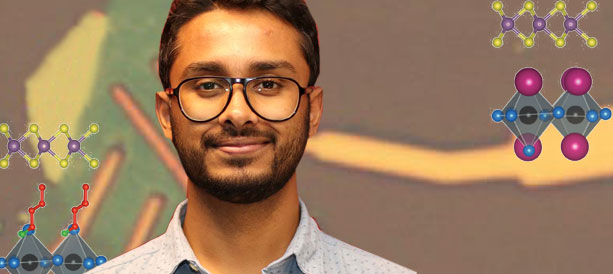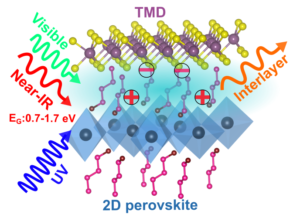
The interface of 2D perovskites with TMDs can lead to new properties—broadband light absorption and emission, and enhanced charge separation across the interface—that could be utilised in future optoelectronics.
Designing hetero-interfaces towards new optoelectronic functionalities using large-scale computations
Assembling ‘Lego-like’ 2D ‘heterostructures’ can give rise to emergent properties and functionalities very different from the intrinsic characteristics of the constituents.
Density functional theory (DFT)-based band-structure calculations can shed light on interfacial properties of different heterostructures.
Interface properties of 2D perovskite/TMD heterostructures
Heterostructures based on different 2D materials have resulted in ‘new’ properties that can be significantly different from those of the individual materials. Such heterostructures can be made by assembling different kinds of atomically-thin 2D materials.
One such family of 2D materials, the 2D perovskites, show interesting photophysical properties and better stability compared to the typical bulk perovskites. However, till now, near-infrared (NIR)/visible-range optoelectronic device performance metrics of 2D perovskites have been quite poor owing to certain intrinsic and materials-specific limitations such as large bandgaps, unusually high exciton binding energies and low optical absorption.

First author Abin Varghese is a joint PhD Student at Monash University (with FLEET CI Nikhil Medhekar) and Indian Institute of Technology Bombay, India
A new study led by researchers from Monash University looks at a methodology to improve the optoelectronic device performance and extend the functionalities of 2D perovskites by conjugating them with optically active transition metal dichalcogenides (TMDs). 2D perovskites and TMDs are structurally dissimilar, however, they can form clean interfaces owing to van der Waals interactions between the stacked layers. Using accurate first principles calculations, the authors demonstrate that the novel interface (band alignment) and transport properties are feasible in 2D perovskite/TMD heterostructures which can be widely tuned based on appropriate choice of the constituents.
To understand the interface properties accurately, the authors created lattice matched structures of the interfaces and explored their properties through highly memory intensive computations using supercomputing facilities.
In specific systems, the predicted type-II alignments with NIR/visible bandgaps can enable enhanced optical absorption at comparatively lower energies. Also, sizeable band offsets and possibility of interlayer excitons with lower dissociation energies can lead to easier interlayer separation of the excited charge carriers across two materials. These render the possibility of achieving higher photocurrents and improved solar cell efficiencies. The researchers also predict the possibility of type-I systems for recombination-based devices like light-emitting diodes and type-III systems for achieving tunnelling transport. Additionally, they also show significant strain tolerance in such 2D perovskite/TMD heterostructures, a pre-requisite for flexible sensors.
“Overall, these findings demonstrate that a computationally-guided selection of heterostructures could offer better platforms than intrinsic materials for specific device applications and have potential in next-generation multifunctional devices such as flexible photosensors or LEDs”, says FLEET CI A/Prof Nikhil Medhekar who led the work with PhD student Abin Varghese and postdoctoral researcher Dr. Yuefeng Yin.
Tuning polarity of photogenerated currents
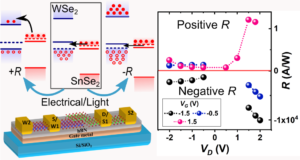
The charge transport mechanism across the WSe2/SnSe2 heterostructure can be controlled either using light or by applying an out-of-plane electric field, which can lead to positive or negative photo responsivity (R).
Exploring the physics of 2D heterostructures further, the team collaborated with experimentalists led by Prof. Saurabh Lodha from IIT Bombay, India to explain the emergence of a yet undiscovered optoelectronic phenomena. In the first work on WSe2/SnSe2 heterostructures, upon illumination, the polarity of the photocurrent showed a dependence on the type of electrical transport (thermionic or tunnelling) across the interface of the heterostructure.
The researchers at Monash employed density functional theory based electric field dependent band-structure calculations and attributed this observation to the nature of band alignment at the interface. Together, they showed that a change in band alignment from type-II to type-III resulted in a change in polarity of photocurrent from positive to negative.
In terms of the performance of photodetectors, the responsivity and response time are crucial metrics. In this study a high negative responsivity and fast response time was experimentally observed in the device prototypes which are encouraging for further development of 2D materials-based devices for practical applications.
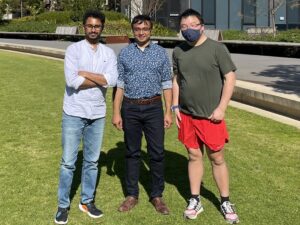
From the Computational Materials Lab at Monash University, from left: PhD candidate Abin Varghese , group leader A/Prof Nikhil Medhekar and Dr Yuefeng Yin.
In another heterostructure comprising black phosphorous and MoS2, the experiments illustrated an illumination wavelength-dependence on the polarity of photoconduction. The negative photoconductance seen at specific wavelengths above the absorption edge of MoS2 could be controllably and reversibly tuned to positive photoconductance at lower wavelengths. The threshold wavelength for crossover between negative and positive photoconductance had a crucial dependence on the flake thicknesses. Thickness-dependent band-structure calculations carried by researchers from Monash clearly showed the possibility of an increase in recombination of charge carriers for specific thicknesses which could lead to negative photoconductance, thus aiding the conclusions.
These studies demonstrate new methods to control the sensing mechanism in photodetectors which has not yet been studied in such details.
The studies
- “Near‐Infrared and Visible‐Range Optoelectronics in 2D Hybrid Perovskite/Transition Metal Dichalcogenide Heterostructures” published in Advanced Materials Interfaces (DOI: 10.1002/admi.202102174)
- “Polarity-Tunable Photocurrent through Band Alignment Engineering in a High-Speed WSe2/SnSe2 Diode with Large Negative Responsivity” published in ACS Nano (DOI: 10.1021/acsnano.1c11110)
- “Wavelength-Controlled Photocurrent Polarity Switching in BP-MoS Heterostructure” published in Advanced Functional Materials (DOI: 10.1021/acsnano.1c11110)
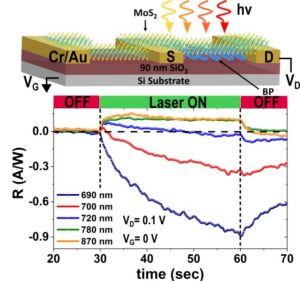
The photo responsivity of the BP-MoS2 heterostructure depends on the incident wavelength of light at the interface.
As well as support from the Australian Research Council and the IITB-Monash Research Academy, assistance was provided in India by the Department of Science and Technology (SwarnaJayanti fellowship) and Ministry of Electronics and Information Technology (Visvesvaraya PhD Scheme). Facilities at the Indian Institute of Technology Bombay Nanofabrication Facility (IITBNF) were used for device fabrication and characterisation. The large-scale computations were enabled by Australia’s National Computational Infrastructure (NCI) and Pawsey supercomputing facilities. The researchers ran their simulations on NCI’s Gadi and Pawsey’s Magnus supercomputers.
More information
- Contact A/Prof Nikhil Medhekar (Monash University) nikhil.medhekar@monash.edu
- Visit Computational Materials Lab, Monash University

